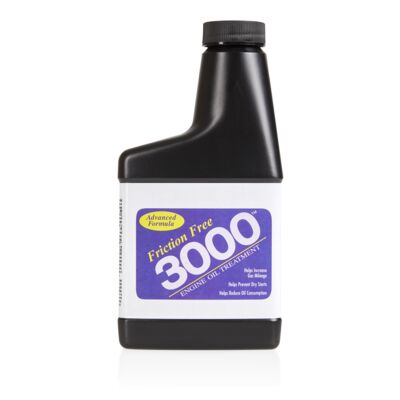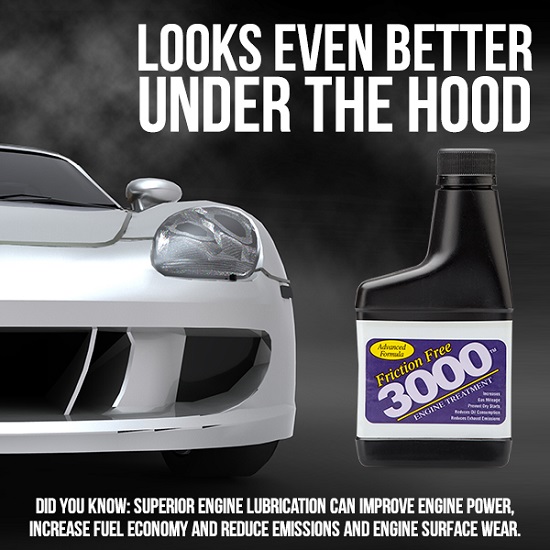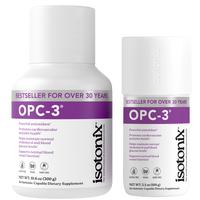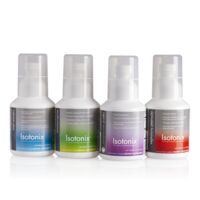Discover a new you with a healthy lifestyle change

Friction Free 3000™ Engine Treatment
sku 6530
$26.95
$ 0.54 Cashback
This product qualifies for free or reduced cost shipping. Learn More
Primary Benefits
- Increases gas mileage
- Prevents dry starts
- Reduces oil consumption
- Better engine performance
- Normal compression
- Decreases engine wear
- Increases engine life

What Makes This Product Unique?

Friction Free 3000 Engine Treatment is an engine oil additive lubricant made of soft ductile metals, uniform and spherical in shape, ranging from 5 to 15 microns in size. These soft metals are coupled with special suspension agents to provide a solid boundary lubrication that can provide enhanced engine performance even under extreme conditions. Friction Free 3000 Engine Treatment has been shown to provide superior engine lubrication, improve engine power, increase fuel economy, reduce emissions and reduce engine surface wear. And it's so easy! It only takes 15 seconds to add a bottle of Friction Free 3000 to your car's oil. Do this after each oil change for best results.
When two hard metal surfaces collide, conventional fluid film lubrication can fail. Friction forces generate tremendous heat, creating intense lubrication demands. Unfulfilled demand and inadequate lubrication can result in: Poor engine performance, lower compression, increased oil consumption, poor mileage, dry starts and increased engine wear and shorter engine life
A step beyond ordinary lubrication. Friction Free 3000 protects and preserves new and old engines alike. Metallurgists in the field of tribology (the study of friction) confirm that soft metals provide superior friction-reducing quality and enhanced lubrication between two hard surfaces. The proper use of Friction Free 3000 Engine Treatment can help increase gas mileage, prevent dry starts and reduce exhaust emissions.
As metal moves against metal, microscopic soft-metal particles migrate into pits, crevices and scratches caused by friction wear. Unlike conventional film lubricants, which cannot properly protect against these conditions, the Friction Free 3000 Engine Treatment micro-metals fill, pack and plate the imperfect surfaces. The remaining micro-metals constantly circulate to provide added lubrication while seeking out new areas of surface wear.
Friction Free is recommended for oil filters having pore sizes of 20 microns or greater.
*It is not recommended for diesel engines, positraction or limited slip differentials, or any unit requiring limited lubrication, common reservoirs (wet clutches), 2-cycle engines where oil and gas are mixed, centrifugal hydraulic systems or high pressure multi-stage compressors over 500 psi. Friction Free 3000 is intended for use in gasoline engines and should be poured into the oil reservoir, NOT the fuel tank. It can be used in small 4-cycle engines. Friction Free 3000 is compatible with both standard and synthetic motor oils.
Instructions: Change the oil and filter or have the oil and filter changed by a qualified professional. Start the engine and allow it to reach regular operating temperature. Stop the engine and immediately add a complete bottle of Friction Free 3000 to your engine's crankcase (where you add your engine oil). Immediately restart the engine and continue to drive the vehicle at normal speeds for at least 10 minutes.
Transmissions and Gearboxes: Friction Free 3000 can be used for standard transmissions, differentials and gearboxes, but is NOT intended for use in limited slip or positraction differentials, or any unit requiring limited lubrication.
Compressors and Hydraulic Systems: Friction Free 3000 may be used in hydraulic systems. Treatment ratio is 2 oz. per gallon up to 5 gallons, then add 1/2 oz. per gallon thereafter. This product is NOT intended for use in high-pressure, multi-state compressors over 500 psi.
Learn More
FAQ
What do you mean by boundary?
There are two levels of lubrication. The first, "hydrodynamics," relates to the film between the surfaces in question. This is the primary purpose of the lubricant. When the film is removed, we need some form of "boundary" or secondary level of protection as the two surfaces are directly in contact with each other — there is no longer a fluid "film" between them. In these extreme cases, Friction Free 3000 Engine Treatment provides a measurable advantage. Plating that occurs on the bearing surfaces with use of Friction Free 3000 provides excellent "boundary" protection to overcome (on a temporary basis) the damage that would be caused with such extreme cases of increased friction and temperatures.
Should I be concerned because of the "lead"?
Friction Free 3000 Engine Treatment uses "elemental" lead. It must be converted from this form to an organic or inorganic compound to pose any significant threat. While caution should be used with all chemical products, the potential risk to a customer is very low and virtually nonexistent if proper handling procedures are used and the bottle instructions are carefully followed.
What can I expect by adding Friction Free 3000 Engine Treatment to my engine oil?
The Friction Free 3000 Engine Treatment micro-metallic formulation can translate into a smoother running engine. Lower operating temperatures, better fuel economy and reduced oil consumption are just a few of the added benefits reported to us by our customers. Because of the plating and more efficient combustion, exhaust gas emissions are also lowered. This means a cleaner and healthier environment for everyone.
Can I use Friction Free 3000 Engine Treatment in other car parts than my engine?
Yes. You will attain similar benefits when you use Friction Free 3000 Engine Treatment in your transmission (standard) and differential. Other uses for machinery, etc., are also listed on our product's packaging.
Can Friction Free 3000 Engine Treatment be used in Diesel Engines?
As the label warning states, Friction Free 3000 Engine Treatment is not recommended for diesel engines because the newer micro-fine filters could become clogged.
Can Friction Free 3000 Engine Treatment be used in hydraulic systems?
Yes. Add 2 oz. per gallon up to 5 gallons, then add ½ oz. per gallon thereafter. For compressors under 500 psi, add 1 oz. per quarter up to 5 gallons, then add 1 oz. per gallon thereafter. Friction Free 3000 Engine Treatment is NOT RECOMMENDED for high-pressure, multi-stage compressors (over 500 psi).
How much Friction Free 3000 Engine Treatment should you use after the initial treatment?
Continue the recommended oil change schedule after the first initial treatment application, adding 4 oz. of Friction Free 3000 Engine Treatment with each oil change.
Can Friction Free 3000 Engine Treatment be used in new or rebuilt engines?
Allow manufacturer's break-in period to elapse before applying Friction Free 3000 Engine Treatment. The period is normally after the first oil change. Please note that the use of the engine treatment may void the manufacturer's warranty.
Will the oil ring on the piston clog or cake up when using Friction Free 3000 Engine Treatment?
No. It will not.
Will Friction Free 3000 Engine Treatment clog up the oil filter?
Not standard oil filters. It can, however, clog up the "toilet tissue" filters (the ones made of very fine material used on customized vehicles, 5-7 micron pore size).
Why should I consider Friction Free 3000 Engine Treatment?
Oils are already blended with additives, which serve various requirements. Dispersants/detergents, oxidation inhibitors, extreme pressure anti-wear agents and friction modifiers are but a few of the many "ingredients" in today's motor oils. Though sufficient, these "additives" do not address the gradual wear, surface irregularities and high demands placed on engines by most drivers. Friction Free 3000 Engine Treatment's unique micro-metallic formulation enhances the lubricity surfaces.
What do you mean by slipperiness?
A lubricant must allow the surfaces to pass along each other with the minimum of friction. Friction is directly related to heat, wear and fuel economy. Friction Free 3000 Engine Treatment increases the lubricity of the oil — allowing the two surfaces to pass smoothly.The particles (spherical in shape) act as microscopic "ball bearings".
Will these "ball bearings" get caught in the oil filter?
Factory filters trap particles in the 20-25 micron range. Through the process of atomization, we select pharmaceutical grade copper and elemental lead for Friction Free 3000 Engine Treatment. These micro metallic elements are smaller, 5-15 microns, so they do not get filtered out. As a reference, baby powder (talc) is in the 20-micron ranges so you can see we are talking very fine down in the 5-15 micron range. Through the incorporation of a patented blend of the micro metals — size, percentage, and concentration — Friction Free 3000 plates the surface imperfections (worn areas). Much like a plasterer who fills imperfections with wall compound, the soft and malleable micro metals in Friction Free 3000 pack, fill and "plate" the irregularities in the bearing surfaces. This aspect of Friction Free 3000 is documented in the U.S. Patent on which our formula is based. This patent number is printed on each bottle, giving us credibility in a competitive area where many products and claims are made without substance. This plating also gives Friction Free 3000 superior "boundary" lubrication characteristics.
LEAD
Lead is a dull gray, soft metallic element. It occurs naturally in many forms but most commonly in the sulfide mineral, galena. The natural galena is processed and elemental lead is produced.
Elemental lead has many uses in its pure state and is particularly important in car batteries. The greatest uses of lead occur from its chemical derivatives such as lead sulfide or lead chloride. The most important and best known use of lead is as an organic derivative, tetraethyl lead, and the anti-knock additive used in gasoline. This compound has been used heavily for several decades.
There is widespread concern over the toxicity of lead and its place in the environment. Well publicized lead toxicity dates back to use of leaded pottery during the Roman civilization. More recently, child poisoning due to lead paint ingestion has made the news. The current concern of lead poisoning and toxicity is the contamination of the environment by automobiles that use leaded gasoline. The use of this component is currently being curtailed and should drop to a negligible amount in the near future.
The toxicity of lead and its compound is serious and should not be taken lightly. However, several factors must be considered if one is to adequately access the risk. While lead poisoning is a serious industrial problem, the mere presence of lead and its compound does not necessarily result in exposure or poisoning. The lead substance must enter the body in some form before any exposure actually exists. It can be taken into the body in any of the three ways: inhalation, ingestion, or absorption through the skin.
When lead or its compounds are ingested, most of it passes through the body unabsorbed. Some are caught by the liver and eliminated in the bile. Some are aborted by the body and begin to accumulate. The effects are generally cumulative and slow to manifest themselves.
When lead or its compounds are inhaled, the bulk of the material is trapped by the upper respiratory system and eliminated through the stomach. Some of the material may reach the lungs where it is trapped. This material is readily absorbed into the blood stream. This type of exposure can result in rapid poisoning and almost immediate symptoms.
Absorption through the skin is not considered a serious problem in most cases. The exception is for organic lead compounds. These materials are readily absorbed and can cause immediate toxicity. The major culprits are compounds like tetraethyl lead.
The level of toxicity in the body is a direct function of the amount of materials that are absorbed. The absorption rate is directly dependent on the type of lead compound. Inorganic lead salts like lead chloride are absorbed fairly easily by the body and are not a serious problem. Organic lead compounds are always a threat. Elemental lead as a species is not absorbed by the body. It must first be converted to a salt by chemical reactions before it is absorbed. Therefore, the risk from exposure due to elemental lead is less than that from other lead compounds. A risk does exist, but the actual level is not well understood. Since lead is a cumulative position, no risk should be overlooked.
Lead poisoning commonly appears as one of several clinical problems. Lead poisoning is most often classified as (a) alimentary; (b) neuromotor; or (c) encephalic. Alimentary toxicity is the most common with the patient experiencing abnormal discomfort with possible constipation, loss of appetite, nausea, vomiting, insomnia, weakness, and joint and muscle pain. Neuromuscular toxicity is most frequently associated with loss of adequate control of the wrist, the hands, the feet and disorientation. Seldom is paralysis observed, but it can happen. Encephalitic toxicity is usually associated with rapid and heavy lead absorption. It is observed as stupor, dizziness, headache, confusion, and often convulsion. In any case, diagnosis should be made only upon confirmatory data from blood and urine tests.
Consider the case for Friction Free 3000 Engine Treatment. This product contains elemental lead dispersed in an oil base. In this condition, it is not likely that material will be inhaled. Upon contact with the skin, it is easily washed off and poses no more threat than handling a lead brick. The primary mode of exposure to the lead would be by ingestion.
If this product were ingested, it could result in assimilation and poisoning. However, consider that only a small amount of the available lead could be absorbed because it is in the wrong form, it is in an oil carrier, and is passed through the digestive system rather quickly. Of course, numerous exposures due to any source can be harmful and any exposure should be avoided if possible.
The potential risk of lead poisoning associated with the use of Friction Free 3000 is very low and virtually eliminated if proper handling procedures are used and the bottle instructions are carefully followed. There is no more risk of lead poisoning while using Friction Free 3000 than from the battery in the car itself.
The vaporization of sulfuric acids containing elemental lead from car batteries poses a much higher risk than the addition of Friction Free 3000 to an engines' crankcase. Tests conducted by Hauser Laboratories (ref. 82-471) showed no increase in lead exhaust emission with the addition of Friction Free 3000 Engine Treatment.
The U.S. Department of Labor's Office of Safety and Health Administration (OSHA) inspected the manufacturing facility and gave its stamp of approval especially when they discovered that Friction Free 3000 Engine Treatment Lubricants used elemental rather than organic/inorganic lead compounds.
Reviews
Displaying 1 - 5 of 20
06/05/2024
by ToddK
Proven over time!
I've used Friction Free in my vehicles for many years. I tend to drive them a long time, and I feel this product really helps the engine to keep running well, can improve gas mileage, and in my wide variety of weather and temp changes, helps all year in all conditions.
Response from Customer Service
06/05/2024
Dear Valued Customer,
Thank you for sharing your positive experience with us! We're delighted to hear that the Friction Free 3000™ Engine Treatment has been a beneficial addition to your vehicles over the years. We are thrilled by your positive experience and continuous support! We truly appreciate your loyalty and trust in our product!
Thank you again!
The Product Information Team
02/22/2024
by ThomasA
Amazing
If anyone has or has had or even knows someone that has the '08-'12 Dodge Charger, they are aware of the possibility of what's called The Lifter Tick. That annoying ticking sound from the engines lifters because the ones installed end up losing their lashers and the push rods to the lifters end up hitting metal on metal. I've replaced the lifter assembly and still had the tick just not as loud unless the car is running in the garage or beside buildings outside. Used Friction Free 3000 with my most recent oil change and was blown away. Not only is my car getting better fuel efficiency, but I literally had to pull over and lean over the hood to listen to the engine run. Tick gone!
Response from Customer Service
02/22/2024
Dear Valued Customer,
Thank you for sharing your experience with Friction Free 3000 Engine Treatment! We're thrilled to hear that it helped eliminate the lifter tick in your Dodge Charger and improve your car's fuel efficiency. If you have any questions or need further assistance, please don't hesitate to reach out. Enjoy the smoother performance of your vehicle!
Thank you again,
The Product Information Team
07/05/2023
by SandraM
Best Product
I have been using this product since 2002. I have a 2002 Kia Rio and I still get 35 mpg in the city.
Response from Customer Service
07/06/2023
Dear Valued Customer,
Thank you for taking the time to share your thoughts on the Friction Free 3000™ Engine Treatment! We are so happy to hear you are pleased with the product!
Thank you again!
The Product Information Team
11/02/2022
by DeanZ
Smooth
I added Friction 3000 to my Subaru with 207k miles and it started running very smooth and effortless.
Response from Customer Service
11/03/2022
Dear Valued Customer,
Thank you for taking the time to share your thoughts on the Friction Free 3000™ Engine Treatment! We are so happy to hear you are pleased with the product!
Thank you again!
The Product Information Team
08/02/2022
by BonnieP
Save on gas reduce emissions!
Both our cars, for years have run smoothly and we saved on gas too. A lifer product for us.
Bonnie Philo
Response from Customer Service
08/02/2022
Dear Valued Customer,
Thank you for taking the time to share your thoughts on the Friction Free 3000™ Engine Treatment! We are so happy to hear you are pleased with the product!
Thank you again!
The Product Information Team
- Prev
- Next



